Updated: 03-Mar-2022
The "M" is the initial that followed by an ordinal number is the official name assigned by the Soviet aviation to designate its engines.
-They were used from WWI until shortly after WWII.
-Before the Revolution in 1917, engines were mainly obtained from Europe and some were manufactured under license, such as the Gnome-et-Rhone "Omega", made by Kalep, for example.
-Later with acquired licenses, the manufacturing was distributed among the different GAZ factories, but all engines of the same type received the same reference.
-There are many unidentified engines, possibly due to being prototypes, others are confused with more modern references.
-We have realized that the name of an engine can be repeated for a totally different one at other times.
-So it is a real mix-up. The conclusion, mention them all as they have appeared in texts and discovered in museums.
-It has also been observed that some M-xxx engines often correspond to the number given by the manufacturer VK-xxx, Ash-xxx or AM-xxx.
-Later we will see that some turbines have the same engine model number as the aircraft.
-Anyway, the main ones were:
-The M-1, inherited by the Bolshevik revolutionaries of the Tsarist era.
-It was built by RBVZ, that is, the "Russko-Baltiyskiy Vagonniy Savod", or rather the "Russian-Baltic Rail Car Factory". Around 1918.
-It was a 150 cv, water-cooled, upright, six-cylinder in-line and was designed by VV. Kireev. It was used in the giant Ilya Murometzs bombers.

“M-1”
-In 1942, an engine derived from the M-105P, redesigned by SD Kolossov and that was initially the M-116P, is designated as M-1. A V-12 that gave 1500 cv.
-The M-2 was a model 9J Oberursel under license and therefore also the Le Rhone 9J (Gnome-Rhone, back then). This was a 9-cylinder rotary radial.
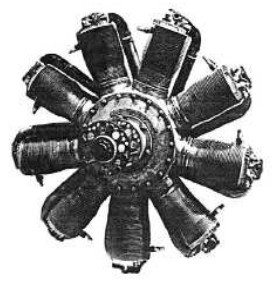
“M-2”
-There were two versions, the 110 cv M-2-110, derived from the “J” model and the 120 cv M-2-120 was derived from the “Jb”.
-The M-3 was a Renault V12 built by the Russkiy car factory in Petrograd. It gave 220 cv.
-A version of the ASh-82FN known as the M-3, twenty years later - at least - did not go into production.
-The M-4 was the Hispano Suiza V-8 manufactured by the automobile brand P.Ilyin de Moscou and also by Anatra in Odessa.
-It was the version of the 200 cv, 8Ab model. Curiously they were called "Russkiy-Ispano" (without the H).
-There is another very modern M-4 GR, which is a rare Ivchenko AI-4V, with 4 horizontally-opposed cylinders giving 55 cv for a small Kamov helicopter. The lightweight Ka-10.
-As we will see, the Hispano Suiza 300 cv, 8Fb version was made as an M-6 model. Around 1925, at the GAZ-9 Factory, former DEKA in Zaporozhye, attempts were made to make engines derived from this M-6, with 12 cylinders and which would be known as "Ispano W".
-The M-4, M-6, and M-12 should not be confused with the MV-4, MV-6, and MV-12 that were the Renault “Bengali” manufactured under license.
-Respectively they were the 4P, 6Q and 12-O, and their derivatives 12-RO and 12F. These engines were manufactured by Voronezh. These Renault engines were known as "Reno".

“M-5”
-The M-5 was an American Liberty under license and made in Rybinsk around 1920.
-It was based on the one manufactured by Ford, model V-12-400 and it was also built at the Russian Bolshevik factory in Leningrad around 1922.
-It gave 500/600 cv. The program was directed by Bessonov and Makaruk.
-In 1925 there were plans to improve it by Brilling and Aleksandrev. Years later even GE type turbochargers were adapted.
-Subsequently, the designation M-5 was used for another engine, a 5-cylinder radial with the intention of being aimed at general aviation, and which was a derivative of the Voronezh M7 and somewhat of the M9F.
-As already mentioned, the M-6 was the Hispano Suiza V8 that gave 300 cv.
-There was the MRB-6 version for the navy (MRB = Russian-Baltic Engine) and M-6T12 for tanks. As we already saw the Ispano W was an evolution for 450 cv.
-Another later M-6 engine has been the Voronezh 340 cv, horizontally-opposed, 6-cylinder engine. This is an engine designed for new aircraft from the year 2000.
-The M-7 was also a small 2-stroke, 2-cylinder engine with only 15 cv that was designed by Bessonov (AB-20) and built at the “Motor” factory.
-Also, recently there is a 7-cylinder M-7 with 270 cv. Also from Voronezh.

“M-7, from Voronezh”
-The M-8, was a high-powered engine, built by RAM, or Russia Aero Motor.
-This engine was designed by Shvetshov and Moiseev. It was a 650/750 cv, 12-cylinder V-engine from which only the prototype was made. There is no further information about the improved RAM-2. It was water cooled.
-With the name M-9 we find those recently made by Voronezh (M-9F).
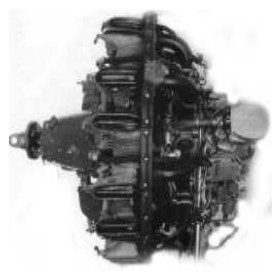
“M-9F”
-The original with M-9 denomination was an experimental Starostin and was a barrel type engine. It gave 400 cv with 8 cylinders.

“M-9”
-And with the same M-9 designation there was a double M-5 Liberty, one placed inverted on top of the other, so that it gave an X-shape.
-The M-10 was a modification of the M-5 owed to Bessonov. It was a 12-cylinder engine with the V at 60° giving 400 cv.
-The Ivchenko AI-10 is also known as M-10.
-We now come to the great engine that was the M-11. And we say "great" because of its track record. It can be said that it is still used today.
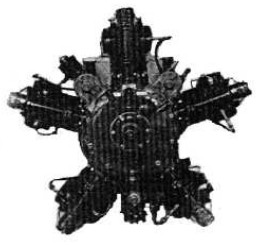
“M-11”
-The design is awarded to Brilling although Mikulin and Charomskiy intervened. But it is built by everyone, like Shvetsov and Okromeshko.
-The evolution has been constant with multiple models but it was also modified by others such as Uvarov, Kossov, and Muzhilov.
-There are series known as -A, -B with new pistons. The -V of 1932. The -G greatly modified. Or the most common 115/125 cv -D based on setting the maximum RPM for the desired power.
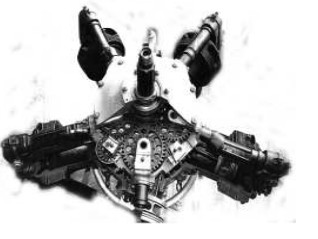
“M-11 distribution”
-Another variant would be the 3M-11, a 3-cylinder M-11 made by Novarov. Or the five-cylinder M-51 as well, or the MG-11 derived from it and the M-48 which was a 7-cylinder M-11.
-The M-11-E and -K built from 1949 reached 125 cv and those that have survived until today, the -F or FR of 140/160 cv.
-In the above photograph we see the distribution gear train that replaces the classic "cam plate" of radial engines.
-The M-12 of 1924, was a derivative of the M-11 that, as we have seen, was designed by Brilling, then underwent a modification by Kossov of which Urmin, another important Russian designer, did not agree, and made his own one too, so we have Kossov's M-12 giving 200 cv.
-The M-12 or M-11 has already been made by Urmin at his OKB-41.
-Ivchenko made it with 7 cylinders in 1947, and at least he also called it M-12. It gave 180 cv.
-Bessonov is credited with another M-12, which was a 700 cv V-12.
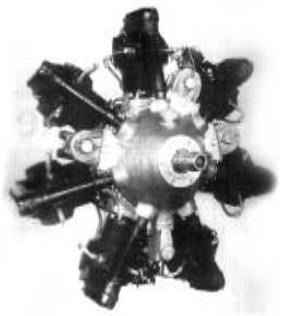
“M-13”
-The radial M-13 used components from the M-11D, M-11FM and MG-31F. it had 7 cylinders.
-As with the M-12, Urmin made his variants from the M-13. It gave 300 cv and used parts of the M-11D and GCS (Geared Centrifugal Supercharger). Another designer, Muzhilov, at OKB-41 made another 250 cv M-13 that did not go into production.
-The Kossov M-13K (1944) had a GCS similar to the 300 cv MG-31.
-The shocking thing, but nothing strange in the big mix-up of Russian denominations, is that there was another, totally different M-13: in 1948 they made an engine that was based on the Wright Tornado T-3. It was the GM-13 version. The G indicates marine engine.
-The M-13M was the Russian version of Wright's T-4, also called Tornado. Mikulin's AM13 (see).
-Another great engine was the M-14, a radial version, built by Ivchenko and now by Veedeneyev.

“M-14, radial”
-As it has had a long life, the radial M-14 has seen all kinds of versions, such as geared, etc. Versions have been seen as -RA, -V, -RF, -RFP, -VF, -RS, -P, -PM, -PMA, -PT, -PF, -PA. -PR, -N, -Kh, -PS, -SKh, -V26, -V26V1, -V1, -V2, and the story continues.
-They were made in Poland by WSK as -RA, -RD or -RDP. In Czechoslovakia as M-362 and M-462. In China as Huo-Sai, HS-6 and HS-6A.
-The Ivchenko AI-14 model is also the M-14, as we see the number of both is related.

“M-14, V-12”
-As in the previous cases, there is a 400 cv, twelve-cylinder, V-engine M-14, designed on the basis of the M-5 by Shvetsov and Dobrynin, taking details of the M-10.
-There also existed a water-cooled, inverted V12 version that gave 450 cv.
-The Kireev MK-14, from the year 1925, was another 12V of 600 cv, reaching up to 950 with the geared version.
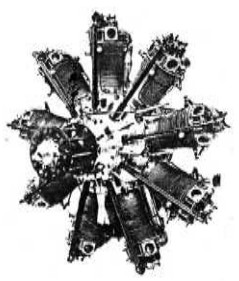
“M-15”
-The M-15 is a copy of the Bristol Jupiter 9-cylinder radial and gives from 450 to 600 cv. Other information brings it closer to a PW Hornet. The truth is that it incorporates original Russian solutions too.
-It passed through the hands of Bessonov in 1930 to give 450 cv. Bessonov's 2M-15 reached 550 cv.
-The M-16 used a single line of cylinders from the M-5, and was projected by Kolossov. In fact it was a half M-14, from the year 1928.
-Another version was the three-row V8-1 (W-engine), with 18 cylinders instead of the M-16's V-12s.
-Another engine with the M-16 designation was the one with four horizontally-opposed cylinders from 1939, which was also owed to Kolossov. It gave 65 cv.
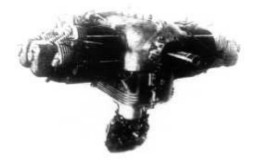
“M-16”
-Voronezh has, since the mid-1990s, another M-16. It is an 8 cylinder X-engine giving 300 cv with injection.
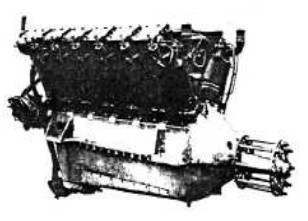
“M-17”

“M-17, rear view”
-The M-17 was another engine that was mass-produced by Mikulin, and that was based on the license of the BMW VI, obtained in efforts made by Klimov.
-The M-17 greatly influenced the design of Mikulin's M-34.
-The work of the M-17 was directed by Mikhailov, with the intervention of a young Klimov. It had its main versions in the M17B, -F and -T.
-Likewise Voronezh made another engine recently named M-17, a horizontally-opposed, 4-cylinder that gave 175 cv and 250 cv in the M-17F version.
-As M-18 we know the Bessonov 18-cylinder in W that gave 1050 cv. But it also appears in some publication as Mikulin's M-18 with 18-cylinder double row radial, something difficult, but very possible.
-More plausible is that the W18 was part of the Kertis W and the M-14. Starting with 800 cv. The Kertis family has the inline 6-cylinder “I”. The "V" of V-12 and the W-18, like Kertis "W".
-Once again Voronezh has made an M-18 with 2 horizontally-opposed cylinders and 2-stroke cycle: the M-18-01 giving 40 cv and the M-18-02 giving 55 cv.
-The M-19 was based on the Kertis V, a V-12 designed by Bessonov and based on many components of the Curtiss D-12.
-The basic engine gave 450 cv, but the M-19K rose to 600 cv and the M-19a reached 650 cv.
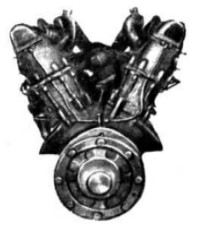
“Kertis V, base del M-19”
-The M-20 was the Mikulin AM-20, designed when it was used at the NAMI (Scientific Automotive Institute). He was currently teaming up with Brilling, Klimov, and Charomskiy.
-The 1928 M-19 is based on some NAMI projects, the M-500 and M-600.

“M-20”
-It had five radially arranged blocks of 4 cylinders each.
-It gave 500 cv and increasing to 800 cv for the M-20A variant that only remained as project.
-The Bolshevik factory made an engine like AMB-20 which was a 2-cylinder, 4-stroke engine that gave 20 cv. An air-cooled boxer.
-Another model M-20 engine had 48 cylinders delivering 2,200 cv, “rhomboid” type with two opposed pistons in each cylinder. The half "AN-20 version, a 24-cylinder M-20 gave 1,700 cv.
-The M-21 was a modification of the M-6, using cylinders from the M-12.
-It was designed by Mikulin in 1928, and it was an air-cooled, four-stroke V8.

“MG-21”
-MG-21s had more roots in Shvetsov's ASh-21s. With solutions and parts from the ASh-82 of 1945, and also from the ASh-62.
-In turn, the M-21 was the basis for the M-26, giving 250 cv at 2,000 rpm.
-The ASh-21 was built in Czechoslovakia as M-21.
-The MG-21 (G, civilian) was also modified by Kossov, giving 220 cv with its 7 cylinders.
-The M-22 was a French Gnome-Rhone 9Aq, in turn licensed by another Bristol Jupiter.
-The M-22A, from the year 1930 gave 567 cv with its nine cylinders.
-The M-22R version, was geared and was the same as the G-R 9AKx.
-The M-22N had a supercharger and there was also a version known as the M-22 "Arctic".
-The M-22U gave way to what would later be known as M-58.

“M-22”

“Another M-22”
-Two M-22 engines have been presented, in the second illustration with a large front exhaust manifold.
-Observe the two branches that are sticking out of the heads of each cylinder, as they have two exhaust valves.
-In the Bristol chapter we see that the Jupiter had 4 valves per cylinder, two intake and two exhaust.
-The M-23 was a 65 cv 3-cylinder radial engine, designed by M. Grigorovitch and V. Dollezhal at the NAMI and was also known as the NAMI-65.
-It used components from the M-12 and later, the M-23 gave rise to the M-50.

“M-23, at the Monino Museum” (PiP)
-As we will see throughout this chapter, Russian engines that are difficult to achieve are being shown here, at least until the arrival of V. Kotelnikov's work, in which some new ones have been added, regarding the first edition of the “AZ” .
-The M-24s were V-12s. The M-24 "Bolshevik I" (AMB-700) gave 700 cv while the AMB-500, known as Bolshevik II gave 500 cv and remained as prototype.

“M-25”
-The M-25 was another historical engine within the Russian motor industry. It was built by Shvetsov under license from the Wright Cyclone R-1820-F3 engine.
-In Russia there was a change from inch to metric measurements in the agreements to obtain the license (1932/34). It gave 700 cv and it was Shvetsov who started building it.
-To improve the M-25 Shvetsov went from GAZ 24 to GAZ 19 in Perm. In 1935 the M-25 had Russian indigenous improvements that made it superior to the original.

“I-16 with an M-25 engine”
-We saw these engines in Spain during the civil war, on the Russian Polikarpov I-15 and I-16 planes incorporated into the "Gloriosa" or Republican Aviation.
-According to the version, the M-25 with nine cylinders, gave 630/775 cv. The M-25A gave 730/750 cv.
-The M25V with 750 cv had a pneumatic starter and the M-25B that delivered 750/775 cv had a supercharger.
-The M-25R, naturally, with reduction gear.
-Later the M-25 would give way to the M-62 and M-63.
-In the above illustration we see the I-16 "series 6" aircraft with an M-25 engine.
-As we will see next, in the "10-series" of the I-16 aircraft an extension was made for the propeller shaft. This device is really very little known.
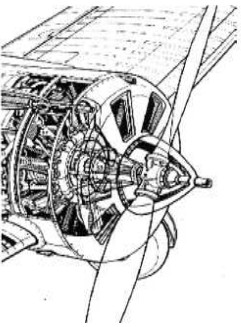
“I-16, 10-series”
-In the photograph below we show this device on an airplane recovered after the Spanish civil war and under construction in the Jerez workshops.
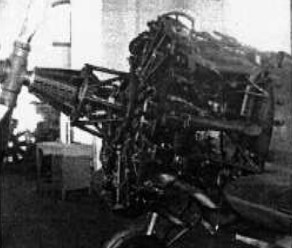
“M-25, with extension for the propeller”
-Of course this extension was a requirement for the design of the new I-16 aircraft.
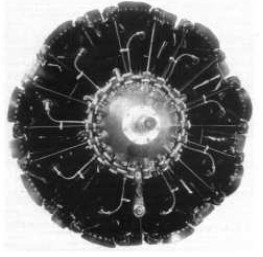
“M-25V”
-For a few years now Voronezh has made a new smaller M-25 engine with only 450 cv, and the turbocharged version M-25-01, for new high-aerobatic aircraft. Both with nine cylinders and a single-speed mechanical supercharger, and fuel injection.
-The M-26 (AI-26), designed by Bessonov and manufactured by Ivchencko began its career in the 1930’s. It was derived from the AI-21 and with assimilated solutions from the M-15. It had 7 cylinders and powers were between 400 and 575 cv.
-It was widely used on the first Mi-1 helicopters with the M-26GR and -GRF engine versions.
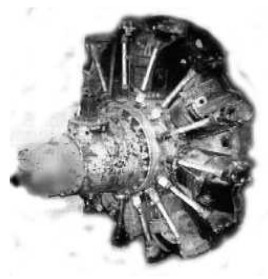
“M-26V (AI-26V)”
-The M-27 was a W-shaped engine, giving 700/900 cv with 18 cylinders. It was derived from the M-19. Both were designed by Bessonov. The M-27 was basic. The M-27R was geared.
-The most common letters used in Russian engines were:
- “R” = Reduction gear.
- “N” = Supercharger or injection.
- “RN” = Reduction and Supercharger.
- “F” = Forsirovanniy, Supercharged engine.
- “D” = Double radial, Dvukhryadniy.
- “TK” = Turbocompressor.
- “G” = Marine.
-Precisely the GM-27 version was an M-27 engine adapted for small boats.
-As in previous cases, Ivchenko produced a 350 cv, 5-cylinder M-27, which has nothing to do with the one mentioned above.
-The M-28 was a large 24-cylinder "X" engine and had another reference as FED-3. It was intended for large bombers such as the TB-4 and TB-7. It was designed, among others, by Balandin and Bessonov (always Bessonov).

“M-28”
-Development companions of the FED-3 that went for 1,500 cv were the 900 cv FED-1 and the 1,000 cv FED-10. All three with the formula of an X-shape engine. The FED-8 (N-5) was planned for 2,000/2,400 cv.
-The M-29 was a 14-cylinder resulting from coupling two 7-cylinder M-26s. According to the record, it was never built, not even the prototype. It was planned for 750/1,000 cv. Another strange M-29 was the 9-cylinder radial giving 750 cv that was derived from the 7-cylinder M-26GR. Bessonov designed it and it was built by Ivchenko.
-As always, in recent times Voronezh has made a 75-cv M-29 with 4 horizontally-opposed cylinders.

“Voronezh M-29”
-The M-30s were designed by Charomskiy (see Charomsky). Specialized in Diesel he made the M-30 (Ach-30), whose silhouette we show to highlight the turbo (one on each side).

“M-30”
-It was based on the first V-12 Diesel AN1-RTK.
-Charomsky also made Ach-31 and Ach-32, later the M-40 (Ach-40).
-Back to the M-30 it was a supercharged 4-stroke V-12 of about 1,500 cv. In 1942, with the M.30F it obtained 1,750 cv and 2,000 cv with the M-30D.
-There was the supercharged Ach-30BF and the Ach-30B was used in a motorjet experiment, driving a compressor to feed an afterburner like the Caproni-Campini and which gave about 875 Kgf of thrust.
-The M-31 was a V-12 similar to the Curtiss Conqueror, but it ran on Diesel and gave 500/600 cv.
-Charomsky's M-31 (Ach-31) from 1942 is documented as 1,900 cv. Diesel too.
-Another thing was the MG-31 which was the M-49 modified by Kossov and derived from the M-11. It is from the same family as the M-21.
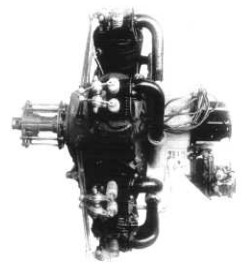
“M-31”
-It started its life in 1933 and the following year it was tested on a bench. It had 9 cylinders and its powers were between 225 and 350 cv.
-The letters MG- were not from “marine” (like GM-27) but from “civil” = Grazhdanskiy.
-The MG-31A had improvements over the MG-31. The MG-31N was fuel-injected and mechanically supercharged.
-The MG-31F was reinforced and improved to 335 cv.
-The -FN and -F2 had fuel injection in relation to the -F and other additional improvements.
-The M-32 was the first engine designed at the IAM in 1930. (IAM = Institute of Aviation Engine Construction).

“M-32”
-It was a 16-cylinder V-engine giving 600/750 cv.
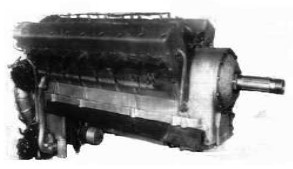
“M-32, 16 cilindros V-engine”
-Not to be confused with the Charomsky Ach-32 12-cylinder diesel V-engine giving 2,300 cv.
-The Mikulin M-33, designed simultaneously with the M-34, also served to build the M-52 that gave 400 cv.
-The M-34 corresponded to the basic version (AM-34 giving 830/950 cv according to application).
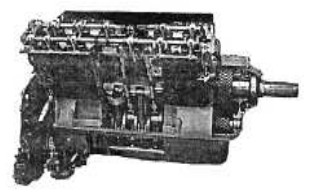
“M-34”
-The M-34 was designed to replace the M-17 (BMW VI) and was in production from 1931 to 1940, with some 10,000 engines being manufactured.
-We see in the above image the gearbox with gears of the “chevron” type (Citröen patent).
-From the M-34 Mikulin's engines were known as AM-34. The year 1936.
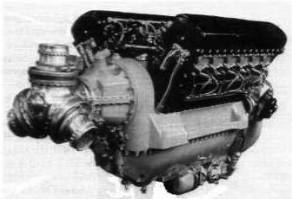
“M-34 FRN”
-Infinity versions were made, even for tanks.
-The AN-34RN gave rise to Diesel engines BD-2 for tanks and the BD-2A for aircraft.
-They were tested with double engines, one of them driving a powerful compressor for stratospheric flights. They were also tested using hydrogen gas. The GM-34 was a marine engine.
-The M-35s were variants of the above M-34. They were designed by A.A. Mikulin (AM-35). They consisted of two M-34 engines coupled by two shafts driving a common gearbox. They were intended for large bombers.
-This engine was from the year 1933 and it was planned for 1,580 cv with a total of 24 cylinders.
-As usual there was the simple M-35, with reinforced blocks of the M-34 in which took part another engineer, M.R. Flissky.
-With half a dozen variants. The 1,200/1,350 cv M-35A was installed on some MiG 1 and 3.
-And also Charomskiy made an M-35 Diesel while he was at TsIAM, trying to make engines in W, X and finally it was a V-engine.
-The M-36 (AM-36) was a Y-engine, using cylinder blocks from the M-34. It was designed in 1939 and had a GCS geared supercharger. It gave 2,000 cv.

“M-36”
-It is known that the M-37 was tested on the Tu-2. As AM-37 it gave 1,500 cv, and was intended for A, TK, P and UV versions.
-It had supercharger and intercooler and was replaceable by the AM-39, due to its dimensions.
-The first application of the M-38 reference seems to be related to a large radial, displacing 77 liters and giving 3,000/3,500 cv, and designed by EV. Kontsevich.
-But the well-known has been Mikulin's M-38 (AM-38), of which more than 43,000 units were made.
-It was a V-12 from 1,300 to 1,680 cv. The -F version it reached 1,770 cv and it was used on the IL-2 "Sturmovich" for ground attack. An aircraft that maintains the world manufacturing record.
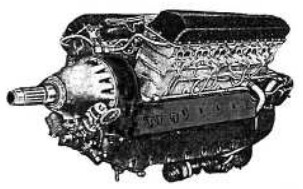
“M-38”
-The M-38 was considered an "armored" engine because it accepted bursts and rifle fire, from the ground.
-There is a GAM-38F marine version.
-The M-39 reached 1,700 cv with the AM-39A and 1,750 cv with the M-39B1 which had a turbocharger.
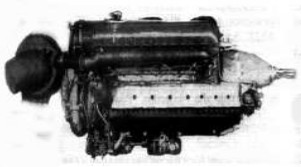
“M-39 with turbocharger”
-The M-39 arose from the M-37 with details from the M-38F such as the intercooler and the two-speed GCS (supercharger).
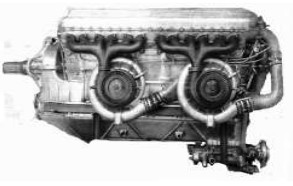
“M-40”
-The M-40 was designed by Charomsky around 1941 and manufactured in Leningrad and Kharkov. It was a V-12 Diesel engine giving about 1,500 cv. As we can see, it had two turbochargers per side, with a total of four.
-Another engine was the MG-40 designed by Kossov based on the De Haviland Gipsy Minor, 145 cv for light and sport aviation. MG = Civil Engine.
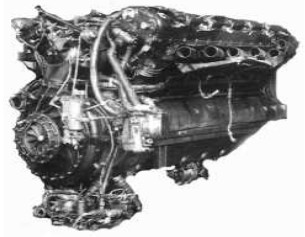
“M-41”
-The M-41 or AM-41, being from Mikulin, was based on the AM-39UV and gave 1,600 cv.
-It was intended to be installed on Russian aircraft similar to the American Aircobra.
-In 1942 Mikulin offered the M-42 (AM-42), an evolution of the AM-38F.

“M-42”
-This was an engine of remarkable success, more than 10,000 units were manufactured. It was also built under license in Czechoslovakia.
-The AM-42s reached 2,000 cv and were made in versions -TK, -FNV, -BTK, or the FB-TK with TK-1 turbocharger.
-Later a 500-cv diesel M-42 is known.
-The M-43 (AM-43) is an evolution of the M-42. It has a two-speed GCS supercharger, they gave about 2,150 cv. There is a compound version with an Efremov reactor.
-The M-44 was another V12 (AM-44) from the year 1944-45 and with powers of 1,700/2,000 cv. The AM-44B-TK also had a TK-1B or TK-300B turbocharger.
-The marine version was the GM-44.
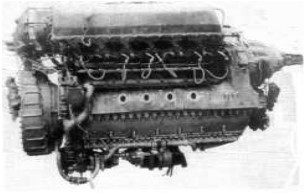
“M-45”
-The M45 is the AM-45 by the same designer Mikulin. It is a variant from the M-44 and whose evolution was taken care of by engineer Flisskiy.
-It had a two-stage, two-speed GCS mechanical supercharger and gave 2,450 cv.
-The M-45D gave 2,700 cv and the M-45Sh would reach 3,000 cv in the year 1948.
-Do not confuse the M-45 reference with the RD-45s, which are the first turbojets built in Russia by Klimov from the RR Nene in 1947.
-The M-46 had to be a high-power air-cooled engine, it finally did not go into production, being known as M-46 a derivative of the M-45 built under the direction of MR Flissky. It was a water-cooled 12V with 46.6 liters of total displacement.
-It was first built in 1946 with 2,550 cv of power. There also were the AM-46TK with TK-300B turbocharger.
-The same thing happens with the M-47, which Flisskiy made it reach 3,000 cv in 1948. It was a water-cooled V-12.

“M-48”
-The M-48 that was designed by Nazarov used parts of the M-11 and was used later to develop the M-49s and M-51s. They had 7 cylinders and used the four-stroke cycle.
-The M-48 became MG-21 when Kossov modified it for civilian use.
-The M-49 was also designed by Nazarov, in 1933, but it had 9 cylinders and gave 270 cv. It was based on the M-11.

“M-50”
-The M-50 was derived from the M-12 and M-23 but with only three cylinders. It was designed by Nazarov and gave 60 cv.
-Interestingly, a Diesel version was made by engineer VM Yakovlev, who was involved in the AN-1 Diesel project as well.
-Kossov made an engine called MG-50, which has nothing to do with the current one, since it was an 18-cylinder two-row radial that gave 950 cv. From this engine not even a prototype was built.
-The M-51 was designed in 1931, from the M-48 and M-49 families and with powers between 125 cv and 145 cv.
-In fact it was the prototype for the MG-11 engine that was built at GAZ-29 in Zaporozhye by Nazarov.
-It was a derivative of the M-11 with 5 cylinders too.
-The M-51 became known as MG-11 when it was modified by Kossov.
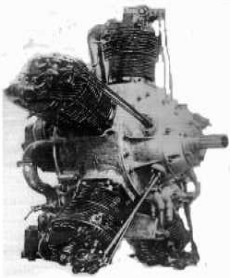
“M-51”
-The M-52 was another Yakovlev Diesel, with 2,400 cv and that was followed by the M-224 which was a copy of the German Junkers Jumo 224. This project was canceled in 1947.
-There is no information is available for the M-53, neither for the M-54.
-The M-55 was an inverted V version of the M-34. It was not mass manufactured because it did not add advantages over the M-34 itself.
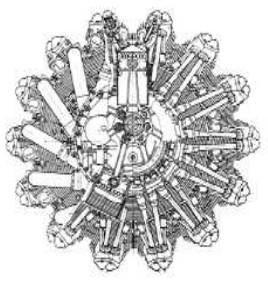
“M-56”
-The M-56 was built under the leadership of Urmin. It was a 14-cylinder, 700-cv radial. The MGM version of the M-56 gave 860 cv in 1937.
-We neither have information on the M-57, M-59, M-60 and M-61 engines.
-The M-58 is a 9-cylinder radial. In fact it is the M-22U.

“M-58”
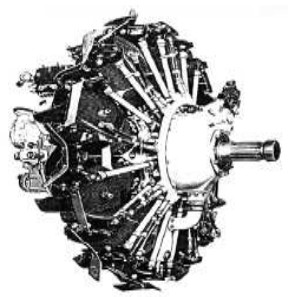
“M-62”
-The M-62 is once again an engine of success. It was based on the Wright Cyclone SR-1820-G103 from the year 1936.
-The M-62 is perhaps Shvetsov's most famous engine. It delivered 1,000 cv. The M-62 equals the Ash-62. It differs from the M-25 in that it has a two-speed GCS supercharger. It is from 1938 and is still manufactured today.
-Since the year 1956 it has been made in China by the Zhuzhou Aeroengine Factory (ZEF) as HS-5, and in Poland since 1960 by the PZL in Kalisz, mounted on Dromader and An-2 aircraft that are built in Poland.
-There were the -R, -IR, -TK, -V, versions. The turbocharged version had the TK-19.
-The -M was an agricultural version Ash-62M that gave 1,000 cv.
-The M-63 engine was a derivative of the M-62, with a compressor and/or reduction gear.
-The M-63-TK carried a TK-1 turbocharger.
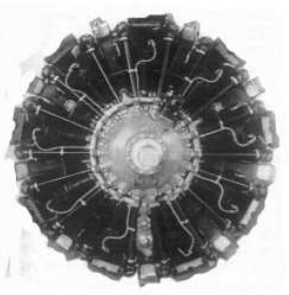
“M-63”
-The same happens with the M-64, which was an improvement of the M-63 and planned for 1,300 cv, although in the official tests it only reached 1,100 cv. Therefore it was not an advance on the M-63.
-The M-65 was not designed by Shvetsov, although it was a derivative of the M-62. It was a 1,100 cv engine and the designers were Bazarov and Bogomolov.
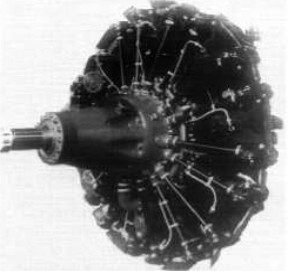
“M-64”
-No information is available on the M-66, M-67, M-68 and M-69, although it is being investigated.
-The M-70 was a double M-25. In fact it was the M25-D18, that is, an 18-cylinder M-25. It delivered 1,500 cv and was from the year 1938. It displaced 60 liters.
-The M-71, M-72 and M-73 are Shvetsov 18-cylinder, radial engines, (that is, Ash-71, etc)
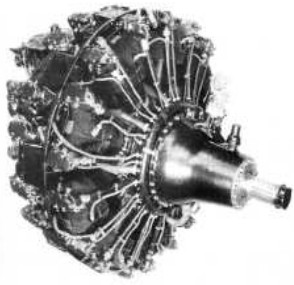
“M-71”
-The M-71 gave 2,000 cv (double version of the M-63). When it was equipped with a TK-3 turbocharger, the M-71F-TK, it gave 2,200 cv.
-The M-72 was even more powerful than the M-71 with a 2-speed supercharger (from the year 1945), although it was displaced by the better M-73.

“M-73”
-The last M-73 was manufactured in Rybinsk in 1957. Among others, it was installed on Tu-4 aircraft (Russian version of the American B-29). The M-73-TK version had two TK-19 turbochargers with intercooler and gave 2,400 cv.
-The M-73 is considered an evolution of the M-72. There is some information that there was an M-73 "compound" but we do not have it at our disposal.
Neither have we information on the M-74. Pending to insert it appendixes when we get hold of it.
-From the M-75 begins a small saga of engines made under license from Gnome-Rhone. When the G-R factory in Riga was nationalized, it is said that it was transferred to Moscow. There the M-2 version of the Le-Rhone J rotary was made.
-The M-22 was also a Jupiter that arrived in Russia through the Gnome-Rhone. So let's start with the M-75, a 9-cylinder radial derived exactly from the G-R "Mistral" 9K. It is from the year 1935 and gave 700 cv with reduction gear.
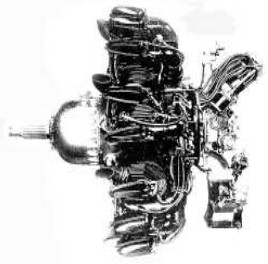
“M-75”
The supercharged M-76 was more powerful with higher rpm. It gave 800 cv.
-We have to mention here that there was another M-76 that was a 45 cv two-cylinder BMW built under license between 1945 and 1955 and that was used on the Kamov Ka-8 light helicopter.
-There is no information on the M-77, M-78 and M-79.
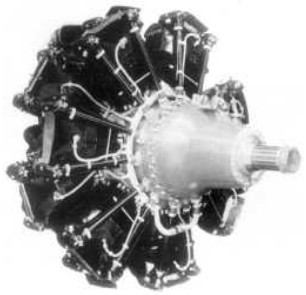
“M-81”
-Now we come to the M-80, a double M-25 but with 14 cylinders, also known as M-25D-14, giving 1,400 cv. The M-80 had a single-speed GCS supercharger and the -R2 version had a two-speed one.
-The M-81 R2, from the year 1939, was a development of the M-80-R2, with 1,500 cv. The one in the above picture was geared.
-In turn the M-82 was an evolved M-81. This engine was from 1944 and it was already known only as Ash-82.
-It was mass-produced during WWII (war known in Russia as the Great Patriotic War).
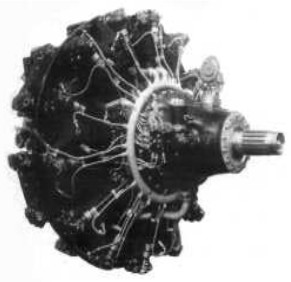
“M-82”
-It was planned for 1,850 cv, and it reached 2,250 cv in the Ash-82 MF model.
-As we see, next to the gearbox it has a small compressor to load the boiler for the pneumatic starter.
-It was manufactured under license in Czechoslovakia (the M-82T) and in China by Dongan as the HS-7 (Ash82V version), and HS-8, (Ash-82T version).
-The M-83, or Ash-83 was a direct derivative of the Ash-82FN. It gave 1,900 cv.
-The M-84 -Ash-84- was an engine derived from the Ash-83 with TK turbocharger, to deliver 1,800 cv.
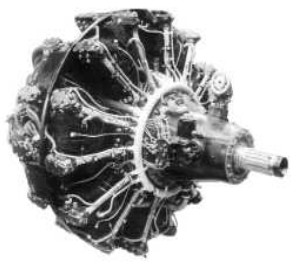
“M-83”
-Even more clearly you can see the compressor attached to the gearbox and just behind the air distributor to the cylinders as if it were a "delco". Above the gearbox and towards the "one o'clock" seen from the front is the propeller governor.

“M-85”
-The M-85 was derived from the 800 cv Gnome Rhone GR-14Kdrs "Mistral Major". It was made by Tumanskiy.
-For a time the M-85 was known as M-70 but later it recovered its initial name, M-85.
-A derivative of the M-85 was the M-86 owing to Nazarov. It reached 950 cv, although it did not replace the M-85 due to lack of reliability. The increase in power was achieved with only 10 kg of weight gain.
-In 1938, the M-87 was made at OKB-29 that was directed by Tumanski at that time. It was a derivative of the Gnome-Rhone GR-14N50, and also derived from the M-85, M-86 and GR-14K. In fact it relieved all of them. Its power was 950 cv.
-There was a Diesel version, the M-87D, with 18 cylinders, from the year 1938 giving 750 cv.
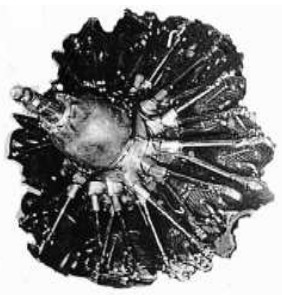
“M-87”
-The M-88, was a derivative of all the previous ones including the M-87.
-It was first known as the M-85V and had a two-speed GCS supercharger.
-With 14 cylinders it reached 1,225 cv and was made in innumerable versions such as -R, -NV, -A, -B, B-NV, -TK (with TK-3), -F, or -FNV.
-There was another interesting version giving 1,090 cv, the M-88-BR. It could rotate RH or LH.
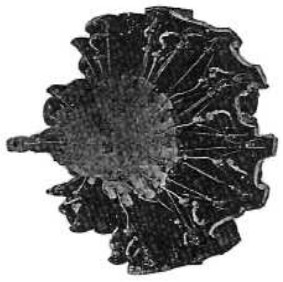
“M-88”
-In 1941, they produced 300 M-88B engines a month.
-There was a coupling of two M-88s, totaling 28 cylinders, but side by side and with a central shaft, and planned for 2,500 cv. It did not reach the prototype stage.

“M-89”
-The M-89 gave between 1,400 and 1,550 cv depending on version. This engine was the last of this Gnome-Rhone family that Shvetsov's team made and developed.
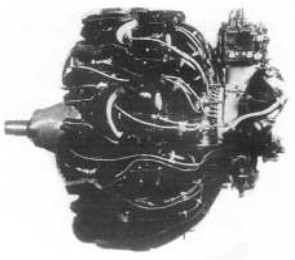
“M-90”
-The M-90 was still considered of the Gnome-Rhone family for carrying cylinders from the M-88. It had 18 of them for a power of 1,950 cv.
-It was built on the OKB-29 directed by Tumanskiy at that time and soon thereafter by Urmin, (the M-90).
-Other sources attribute it to Shvetsov, with 2,100 cv and consider it a copy of the Wright R-3350. Although obviously, it does not seem so.
-There is no information on the M-91.
-The M-92 is believed to have been an evolution from the M-90 without knowing whether it entered into production.
-Neither is there information on Shvetsov's M-93 (Ash-93). Nor the M-94.
-There is little information on the M-95. It mounted cylinders of the M-88 and gave from 2,000 to 3,000 cv.
-We neither have information on the M-96, M-97, M-98 and M-99 engines.
-Another thing is the M-100 engine, a great engine owing to Klimov. It was a 12-cylinder V-engine and licensed by Hispano-Suiza for their 12 Ydrs engine. It gave 760 cv. The M-100A engine reached 860 cv.
-The history of the M-100 started at DEKA with another 100 cv engine. And not designed by Klimov precisely. DEKA is Dyuflon & Konstantinovich.
-From Klimov's M-100 engines, the M-100AU was the "long-life" one.

“M-100”
-A prototype of two M-100s was made in tandem or coupled.
-The "Cannon-Motor" version was that of the Hispano-Suiza 12Ycrs. The M-100So from 1938 reached 1,000 cv.
-Dobrotvorskiy made a 2,200 cv, 24-cylinder, X-shape, water-cooled, geared engine with a one-stage, one-speed GCS.
-Derived from this engine were the M-101, of which little is known, the 950 cv M-102, and the M-103 that was the same as the 860 cv M-100A equipped with a compressor.
-The M-103 was basically the Hispano-Suiza 12Y-51. The M-103s went to Spain and China. The M-103A was from 1939.
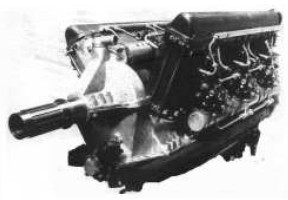
“M-103”
-The M-103P carried a 20mm cannon.
-The M-103SP was an M-103P tandem version.
-The M-103G used glycol instead of cooling water. It was designed in 1938 and gave 930 cv. The M-103A-TK carried a TK-3 turbocharger.
-The M-103U was the "long life" version.
-There are some engines, the MB-100 and MB-102 that are from Dobrotvorskiy, made up of two M-103s. They were X-shaped and had 24 cylinders each. They delivered 2,200 and 2,500 cv, respectively.
-There is little known about the M-104, because it was no event. It evolved from the M-103 with single-stage, two-speed GCS giving 1,100 cv.
-However, Klimov's M-105 (VK-105) was another great engine, in 1951 they manufactured 500 engines a month. It was derived from the M-103A, reinforced.
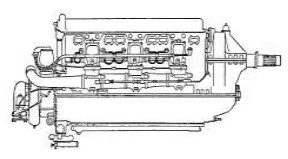
“M-105”
-It also was a 12-cylinder V-engine and was derived from the H-S engine. The basic version gave 1,100 cv. The VK-105P we see on the Lagg-3 fighter, the R version on the Pe-2, the PA version on the Yak 1 and 7 but with reinforced connecting rods. The 1260 cv PF version was mounted on the Yak 3 and 9.
-The turbocharged engines were the PD and FN (TKZ turbocharger).
-At the GAZ-27 factory they developed X-engine prototypes based on this engine. As well as the M-105 in tandem (Coupled).
-The M-106 is an M-105 had major supercharging and had the same dimensions. The -PV was planned for higher altitudes. The -TK had two TK-1 turbochargers.
-The M-107A that had a GCS with of variable incidence blades gave 1,600 cv. There is also a coupled version with two contra-rotating propellers.
-But the most interesting project is that of the VK-107R-E3020 with a coupled motor-reactor, as used on the prototype of the I-250 aircraft.
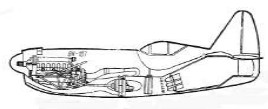
“I-250 aircraft”
-The engine was driving a compressor, then there was a battery of injectors and a combustion chamber with an outlet through a nozzle in the tail. The design was due to two engineers known as Fedeev & Kolschevnikov. This was in the years 1943-45.
-The M-107 was a good engine, with good results, the VK-107A that gave 1,650/1,700 cv was installed on the MiG-7. In fact it is said that it was the HS-12Z-89 version, which was also manufactured in Barcelona for the Me-109 built by Hispano Aviation in Seville.

“M-108”
-The M-108 that came out in 1946 was also from Klimov. Therefore it was named VK-108.
-It was a development of the VK-107A with more supercharging giving 1,850 cv.
-Surely the rotation speed was higher, you just have to compare the gearbox and the size of the upper gear with that of the M-103.
-The VK-108F version was even more supercharged and gave 2,000 cv.
-The M-109 was just like the M-108. It gave 1900 cv. Its short-life began in 1946 and ended in 1947.
-The M-110 engine project was interesting for its mixed cooling system, with glycol in the cylinder heads and air in the cylinders. It delivered about 950 cv and it had the cylinders in inverted V. The engine was from 1939.
-It is easy to confuse with another project, the VK-110, which was twice as large, with 2,000/3,000 cv. It was from 1947 but it did not prosper because the transition to turbojets had begun.
-The numbering of the M- engines was supposed to follow shortly after WWII, but the confusion began as they were both known as M- and by the designer's initials, perhaps in recognition of the merits of his intervention in the Victory of the Great Patriotic War.
-The confusion lasted a bit longer, as with Mikulin's M-205 and M-206, or the M-209 that was already equivalent to the RD-3 turbojet.
-References with the letter M- are currently mentioned again, such as the Bakanov M-16, M-17, M-18 and M-19. And on top of that, knowing that the M-16 is intended - initially - to replace the veteran M-14.
-Trying to continue along the marked path, the next engine -after the small reflection above- would be the M-111-TK, an engine due to ND Kuznetsov. This engine is from the year 1947 and before Kuznetsov dedicated himself to the development of the German Jumo 004 as RD -10 (which was followed by R-12 and R-14).
-The M-111 had 36 cylinders and the project was canceled in 1948 due to what was said above for the M-110..
-From this moment on, only a few names that start with M- are known sporadically, for example the already discussed M-116P, which was M-1 at GAZ-16.
-The M-116 (M-1) is considered a modernization of the M-105 series.
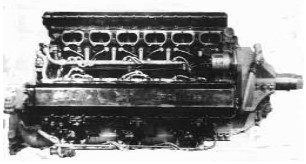
“M-116, (M-1)”
-The next known engine would be the M-120, an inverted "Y" engine. In short, an inverted M-103 with a line of 6 cylinders in block identical to that of the M-103 so that the lower part is at 60° and the upper part at 150° on both sides.

“M-120”
-In a publication it is mentioned that the M-120 was intended for the IS-4 variable geometry fighter.
-The IS-1 and IS-2 aircraft were designed by Nikitin Shevchenko, as was the IS-4. The story is that the rapid advance of the Wehrmacht in Russia, around 1941, surpassed the factory and in the urgent evacuation the papers of the flight records were lost. Now, from the rows of exhausts that we see in the IS-4 aircraft design in the illustration below, it seems rather that it had an H or X engine for the four rows of exhaust.
-It is said that it was later supplied on flights by an AM-37.
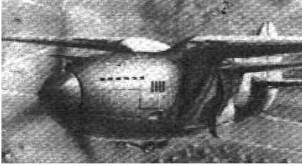
“IS-4”
-The M-130 is known to have been a water-cooled, 4-stroke, 24-cylinder H-engine. It had a gearbox and a two-speed supercharger. It was inspired by Napier's Dagger.
-The M-200 was made by TsIAM. It was a 2-stroke engine with two opposed pistons in each cylinder with 6 cylinders in line. It gave 700 cv and was based on the German Jumo but not Diesel. The engine had two crankshafts with a common gearbox and was designed by V.N. Formin.
-For the M-224, see the M-52.
-The engine series that begins with the reference M-250 are from Dobrynin and Skubachevskiy.
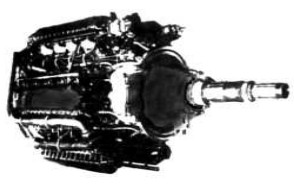
“M-250”
-The M-250 had 6 rows of 4 cylinders, 24 in total, "hexagonal" shape. It reached 2,500 cv.
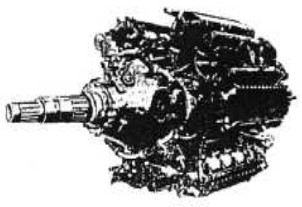
“M-251”
-The M-251-TK, with 3,500 cv was known as VD-3TK as well. It had a TK-19 turbocharger. And it had the same architecture as the M-250. This also counts for the M-253K with the highest displacement delivering more than 4,000 cv. Due to the length and different diameters of the propeller shafts, they had to be contra-rotating.

“M-253K”
-The M-253 was liquid cooled like the previous ones. The front fan misleads, possibly because the water radiators were behind it.
-From the M-300 we know that it had 36 cylinders and gave 3,000 cv, owing to Bessonov.
-We could mention that the M-501 was planned for 6,000 cv with 42 cylinders and running on Diesel.
-After the War and already in the 1950’s the RD denomination predominates Soviet engines. The letters RD correspond to "Reaktiviniy Dvigatel" or Reaction Engine. And as we will see, it applies to both turbines and rocket engines.
-So, throughout this publication we see the RD-10, RD-11, RD-20, RD-21, RD-45 (ex M-45), RD-37, RD-50 etc., nothing to do with the M-10, M-11, M-20, M-21, etc.
-When starting the manufacture of turbines with German technicians and technology, the M-004 was made. This was the Russian version of the Jumo 004 that gave 745 Kgf of thrust and was intended for the Yak 15 and 17 aircraft.
-Koubischev's M-012 was a copy of the Jumo 012, but not much improved.
-The Koubischev M-018 was a copy, or Russian version of the BMW 109-018. The M-022 was the Junkers PTL 109-022.
-Remember here that the Klimov W2 was the tank version of the Hispano-Suiza 12Y, 600 cv engine. They were used on the T-34 to T-54, and Su-85 and Su-100 tanks.
From Appendix 6: In a curious WWI photograph of a captured Russian plane near Lotzen. We show it here because it is a rotary made in Russia under license from Oberursel 9-J (in turn Le-Rhone 9J). It is probably an M-2.
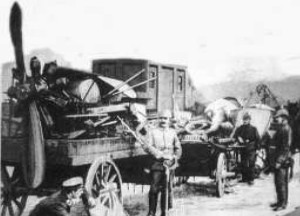
"German troops with seized material"
From Appendix 7: The M-5 engine was an American Liberty made under license in the USSR. It had several applications but the most original may be the one showed below.

"Strange Flying Tank Concept"
-To give mobility to the armored forces it was planned that this Russian BT-2 tank could fly quickly to the right place.
-For this, a structure was built -as a prosthesis- and the tank's own engine (A liberty M-5 built in Rybinsk) was used, sticking out through an extension at the rear and driving a propeller.
From Appendix 10: We obtained a photograph from a Russian publication on the M-27 W-18 engine owing to Bessonov. We can see the Hispano-Suiza style cylinder blocks.

"Bessonov's M-27"
-The Tupolev SB-2 “Katiuska” planes that arrived for the republican government army were powered by the M-100 engines, already discussed in this publication.
-As from 1940 this light bomber aircraft was modernized and repowered with the M-103, M-104 and M-105. In addition, in the case of the M-103 and M-105, a turbocharger was attached to them to operate at higher altitudes. They were the TK-2 and TK-2B turbochargers.
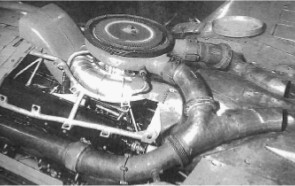
“TK-2 on an M-103”
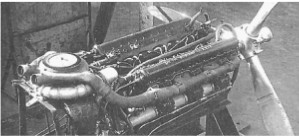
“K-2B on an M-105”
-In the illustration above just at the end of the exhaust, at the outlet, you can see the wingtips that will control the turbo speed. What Americans call the "Waste Gate". In this case it serves to divert the gases under pressure to the outside instead of passing them through the turbine.
-Under the turbines we see the bodies of the centrifugal compressors.
Engines of M
Model: M-1, 6 cyl. built by RBVZ
Arquitecture: 6-cylinder In-line
Cooling: Liquid
Total Displacement:
Bore / Stroke:
Power: 150 CV
Weight:

"M-1"
Model: M-10, (M-5 Up-rated by Bessonov)
Arquitecture: 12-cylinder V-Engine
Cooling:
Total Displacement:
Bore / Stroke:
Power: 400 CV
Weight:
Model: M-100, V-12 by Klimov (H-S 12Y, Lic.)
Arquitecture: 12-cylinder V-Engine
Cooling:
Total Displacement:
Bore / Stroke:
Power: 860 CV
Weight:

"M-100"
Model: M-101, V12
Arquitecture: 12-cylinder V-Engine
Cooling:
Total Displacement:
Bore / Stroke:
Power:
Weight:
Model: M-102, 950 HP, derrived from M-100A
Arquitecture: 12-cylinder V-Engine
Cooling:
Total Displacement:
Bore / Stroke:
Power: 950 CV
Weight:
Model: M-103, 860 HP with compressor (Lic. H-S 12Y-51)
Arquitecture: 12-cylinder V-Engine
Cooling:
Total Displacement:
Bore / Stroke:
Power: 930 CV
Weight:

"M-103"
Model: M-104, evolution from M-103
Arquitecture: 12-cylinder Y-engine
Cooling:
Total Displacement:
Bore / Stroke:
Power: 1100 CV
Weight:
Model: M-105, (VK-105), great success
Arquitecture: 12-cylinder V-Engine
Cooling:
Total Displacement:
Bore / Stroke:
Power: 1100 CV
Weight:

"M-105"
Model: M-106, (M-105 with big compressor)
Arquitecture: 12-cylinder V-Engine
Cooling:
Total Displacement:
Bore / Stroke:
Power:
Weight:
Model: M-107, special compressor, 1700 HP
Arquitecture: 12-cylinder V-Engine
Cooling:
Total Displacement:
Bore / Stroke:
Power: 1600 CV
Weight:
Model: M-108, (VK-108), V-12 (1946)
Arquitecture: 12-cylinder V-Engine
Cooling:
Total Displacement:
Bore / Stroke:
Power: 1850 CV
Weight:

"M-108"
Model: M-109, similar to M-108, 1900 CV
Arquitecture: 12-cylinder V-Engine
Cooling:
Total Displacement:
Bore / Stroke:
Power: 1900 CV
Weight:
Model: M-11, radial, 5 cyl. (great success)
Arquitecture: 5-cylinder Radial
Cooling:
Total Displacement:
Bore / Stroke:
Power: 160 CV
Weight:

"M-11"
Model: M-110, V inverted, experimental
Arquitecture: 12-cylinder Inverted V-engine
Cooling:
Total Displacement:
Bore / Stroke:
Power: 950 CV
Weight:
Model: M-111, y -TK, Kuznetsov
Arquitecture: 36-cylinder
Cooling:
Total Displacement:
Bore / Stroke:
Power:
Weight:
Model: M-112, no information
Arquitecture:
Cooling:
Total Displacement:
Bore / Stroke: x
Power:
Weight:
Model: M-113, no information
Arquitecture:
Cooling:
Total Displacement:
Bore / Stroke: x
Power:
Weight:
Model: M-114, no information
Arquitecture:
Cooling:
Total Displacement:
Bore / Stroke: x
Power:
Weight:
Model: M-115, no information
Arquitecture:
Cooling:
Total Displacement:
Bore / Stroke: x
Power:
Weight:
Model: M-116, (M-105 modernized)
Arquitecture: 12-cylinder V-Engine
Cooling:
Total Displacement:
Bore / Stroke:
Power:
Weight:

"M-116, (M-1)"
Model: M-117, no information
Arquitecture:
Cooling:
Total Displacement:
Bore / Stroke: x
Power:
Weight:
Model: M-118, no information
Arquitecture:
Cooling:
Total Displacement:
Bore / Stroke: x
Power:
Weight:
Model: M-119, no information
Arquitecture:
Cooling:
Total Displacement:
Bore / Stroke: x
Power:
Weight:
Model: M-12, derrived from M-11
Arquitecture: 5-cylinder Radial
Cooling:
Total Displacement:
Bore / Stroke:
Power: 200 CV
Weight:
Model: M-120, original Y-engine
Arquitecture: Inverted Y-engine
Cooling:
Total Displacement:
Bore / Stroke:
Power:
Weight:

"M-120"
Model: M-121, no information
Arquitecture:
Cooling:
Total Displacement:
Bore / Stroke: x
Power:
Weight:
Model: M-122, no information
Arquitecture:
Cooling:
Total Displacement:
Bore / Stroke: x
Power:
Weight:
Model: M-123, no information
Arquitecture:
Cooling:
Total Displacement:
Bore / Stroke: x
Power:
Weight:
Model: M-124, no information
Arquitecture:
Cooling:
Total Displacement:
Bore / Stroke: x
Power:
Weight:
Model: M-125, no information
Arquitecture:
Cooling:
Total Displacement:
Bore / Stroke: x
Power:
Weight:
Model: M-126, no information
Arquitecture:
Cooling:
Total Displacement:
Bore / Stroke: x
Power:
Weight:
Model: M-127, no information
Model: M-128, no information
Model: M-129, no information
Model: M-13, 7 cyl.
Arquitecture: 7-cylinder Radial
Cooling:
Total Displacement:
Bore / Stroke:
Power: 300 CV
Weight:

"M-13"
Model: M-130, 24 cyl. H-engine
Arquitecture: 24-cylinder H-Engine
Cooling:
Total Displacement:
Bore / Stroke:
Power:
Weight:
Model: M-14, 9 cyl. radial (Veedeneyev)
Arquitecture: 9-cylinder Radial
Cooling:
Total Displacement:
Bore / Stroke:
Power:
Weight:

"M-14"
Model: M-15, 9 cyl. radial (Lic. Jupiter)
Arquitecture: 9-cylinder Radial
Cooling:
Total Displacement:
Bore / Stroke:
Power: 600 CV
Weight:

"M-15"
Model: M-16, 6 cyl. inline Kolossov
Arquitecture: 6-cylinder In-line
Cooling:
Total Displacement:
Bore / Stroke:
Power:
Weight:
Model: M-17, V-12 (Lic. BMW VI)
Arquitecture: 12-cylinder V-Engine
Cooling:
Total Displacement:
Bore / Stroke:
Power:
Weight:

"M-17, rear view"
Model: M-18, 18W Bessonov
Arquitecture: 18-cylinder W-engine
Cooling:
Total Displacement:
Bore / Stroke:
Power: 1050 CV
Weight:
Model: M-19, V-12 base from Kertis V
Arquitecture: 12-cylinder V-Engine
Cooling:
Total Displacement:
Bore / Stroke:
Power: 450 CV
Weight:
Model: M-2, 9 cyl. radial-rotary (Oberursel 9J, Lic.)
Arquitecture: 9-cylinder Rotary
Cooling:
Total Displacement:
Bore / Stroke:
Power: 110 CV
Weight:

"M-2"
Model: M-20, 20 cyl. radiales, water
Arquitecture: 20-cylinder Radial
Cooling: Liquid
Total Displacement:
Bore / Stroke:
Power: 500 CV
Weight:

"M-20, drawing"
Model: M-200, 6 cils. inline
Arquitecture: 2-stroke6-cylinder Opposed piston engine
Cooling:
Total Displacement:
Bore / Stroke:
Power:
Weight:
Model: M-21, 7 cyl. radial (Ash-21)
Arquitecture: 7-cylinder Radial
Cooling:
Total Displacement:
Bore / Stroke:
Power: 270 CV
Weight:

"MG-21"
Model: M-22, 9 cyl. Gnome-Rhone 9Aq, Lic.(Bristol Jupiter)
Arquitecture: 9-cylinder Radial
Cooling:
Total Displacement:
Bore / Stroke:
Power: 567 CV
Weight:

"M-22"
Model: M-224, derrived from M-52
Arquitecture: 24-cylinder
Cooling:
Total Displacement:
Bore / Stroke:
Power:
Weight:
Model: M-23, 3 cyl. radial
Arquitecture: 3-cylinder Radial
Cooling:
Total Displacement:
Bore / Stroke:
Power: 65 CV
Weight:

"M-23, on Monino" (PeT)
Model: M-24, V-12
Arquitecture: 12-cylinder V-Engine
Cooling:
Total Displacement:
Bore / Stroke:
Power: 700 CV
Weight:
Model: M-25, 9 cyl. radial. Wright Cyclone Lic.
Arquitecture: 9-cylinder Radial
Cooling:
Total Displacement:
Bore / Stroke:
Power: 700 CV
Weight:

"M-25"
Model: M-250, 24 cyl. “exagonal”, 2500 CV
Arquitecture: 24-cylinder
Cooling:
Total Displacement:
Bore / Stroke:
Power: 2500 CV
Weight:

"M-250"
Model: M-251, similar to M-250, with TK
Arquitecture: 24-cylinder
Cooling:
Total Displacement:
Bore / Stroke:
Power: 3000 CV
Weight:

"M-251"
Model: M-252, no information
Model: M-253, bigger M-251, 4000 CV
Arquitecture: 24-cylinder
Cooling: Liquid
Total Displacement:
Bore / Stroke:
Power: 4000 CV
Weight:

"M-253K"
Model: M-26, 7 cyl. Bessonov
Arquitecture: 7-cylinder Radial
Cooling:
Total Displacement:
Bore / Stroke:
Power: 575 CV
Weight:

"M-26V (AI-26V)"
Model: M-27, 18W, Bessonov
Arquitecture: 18-cylinder W-engine
Cooling:
Total Displacement:
Bore / Stroke:
Power: 900 CV
Weight:

"M-27, Bessonov"
Model: M-28, 24 cyl. X-engine (Balandin-Bessonov)
Arquitecture: 24-cylinder X-engine
Cooling:
Total Displacement:
Bore / Stroke:
Power: 1000 CV
Weight:

"M-28"
Model: M-29, 14 cyl. (2xM-26)
Arquitecture: 14-cylinder Radial
Cooling:
Total Displacement:
Bore / Stroke:
Power: 1000 CV
Weight:
Model: M-3, V-12, Renault Lic.
Arquitecture: 12-cylinder V-Engine
Cooling:
Total Displacement:
Bore / Stroke:
Power: 220 CV
Weight:
Model: M-30, V-12 Diesel (Charomsky)
Arquitecture: 4-stroke12-cylinder V-Engine
Cooling:
Total Displacement:
Bore / Stroke:
Power: 1500 CV
Weight:

"M-30"
Model: M-300, 36 cyl. 3000 HP. Bessonov
Arquitecture: 36-cylinder
Cooling:
Total Displacement:
Bore / Stroke:
Power: 3000 CV
Weight:
Model: M-305
Arquitecture:
Cooling:
Total Displacement:
Bore / Stroke: x
Power:
Weight:
Model: M-31, radial, 350 HP
Arquitecture: 9-cylinder Radial
Cooling:
Total Displacement:
Bore / Stroke:
Power: 350 CV
Weight:

"M-31"
Model: M-32, V-16 from 1930
Arquitecture: 16-cylinder V-Engine
Cooling:
Total Displacement:
Bore / Stroke:
Power: 750 CV
Weight:

"M-32, V16"
Model: M-33, V-12, Mikulin
Arquitecture: 12-cylinder V-Engine
Cooling:
Total Displacement:
Bore / Stroke:
Power: 400 CV
Weight:
Model: M-34, V-12, Mikulin
Arquitecture: 12-cylinder V-Engine
Cooling:
Total Displacement:
Bore / Stroke:
Power: 950 CV
Weight:

"M-34"
Model: M-35, V-12 up-rated M-34
Arquitecture: 12-cylinder V-Engine
Cooling:
Total Displacement:
Bore / Stroke:
Power: 350 CV
Weight:
Model: M-36, 18 Y-engine
Arquitecture: 18-cylinder Y-engine
Cooling:
Total Displacement:
Bore / Stroke:
Power: 2000 CV
Weight:

"M-36"
Model: M-37, 1500 CV
Arquitecture: 12-cylinder V-Engine
Cooling:
Total Displacement:
Bore / Stroke:
Power: 1500 CV
Weight:
Model: M-38, V-12 de Mikulin
Arquitecture: 12-cylinder V-Engine
Cooling:
Total Displacement:
Bore / Stroke:
Power: 1680
Weight:

"M-38"
Model: M-39, V-12, 1700 CV, Mikulin
Arquitecture: 12-cylinder V-Engine
Cooling:
Total Displacement:
Bore / Stroke:
Power: 1700 CV
Weight:

"M-39 with turbocharger"
Model: M-4, V8 Lic. Hispano-Suiza
Arquitecture: 8-cylinder V-Engine
Cooling:
Total Displacement:
Bore / Stroke:
Power: 200 CV
Weight:
Model: M-40, V-12 Diesel, Charomsky
Arquitecture: 12-cylinder V-Engine
Cooling:
Total Displacement:
Bore / Stroke:
Power: 1500 CV
Weight:

"M-40"
Model: M-41, V-12, Mikulin
Arquitecture: 12-cylinder V-Engine
Cooling:
Total Displacement:
Bore / Stroke:
Power: 1600 CV
Weight:

"M-41"
Model: M-42, Up-rate M-38 de Mikulin
Arquitecture: 12-cylinder V-Engine
Cooling:
Total Displacement:
Bore / Stroke:
Power: 2000 CV
Weight:

"M-42"
Model: M-43, evolution from M-42
Arquitecture: 12-cylinder V-Engine
Cooling:
Total Displacement:
Bore / Stroke:
Power: 2150 CV
Weight:
Model: M-44, V-12, 1700/2000 HP
Arquitecture: 12-cylinder V-Engine
Cooling:
Total Displacement:
Bore / Stroke:
Power: 2000 CV
Weight:
Model: M-45, V-12, derrived from M-44
Arquitecture: 12-cylinder V-Engine
Cooling:
Total Displacement:
Bore / Stroke:
Power: 2450 CV
Weight:

"M-45"
Model: M-46, V-12, derrived from M-45
Arquitecture: 12-cylinder V-Engine
Cooling:
Total Displacement:
Bore / Stroke:
Power: 2550 CV
Weight:
Model: M-47, V-12, Flissky
Arquitecture: 12-cylinder V-Engine
Cooling:
Total Displacement:
Bore / Stroke:
Power: 3000 CV
Weight:
Model: M-48, radial, 7 cyl. de Kossov
Arquitecture: 4-stroke7-cylinder Radial
Cooling:
Total Displacement:
Bore / Stroke:
Power:
Weight:

"M-48"
Model: M-49, 9 cyl. de Nazarov
Arquitecture: 9-cylinder Radial
Cooling:
Total Displacement:
Bore / Stroke:
Power: 270 CV
Weight:
Model: M-5, Lic. Liberty
Arquitecture: 12-cylinder V-Engine
Cooling:
Total Displacement:
Bore / Stroke:
Power: 600 CV
Weight:

"M-5"
Model: M-50, 3 cyl. de Nazarov
Arquitecture: 3-cylinder Radial
Cooling:
Total Displacement:
Bore / Stroke:
Power: 60 CV
Weight:

"M-50"
Model: M-501, 42 cyl.
Arquitecture: 42-cylinder
Cooling:
Total Displacement:
Bore / Stroke:
Power: 6000 CV
Weight:
Model: M-51, 145 HP (1931)
Arquitecture: 5-cylinder Radial
Cooling:
Total Displacement:
Bore / Stroke:
Power: 145 CV
Weight:

"M-51"
Model: M-52, Diesel, Jumo based
Arquitecture: 24-cylinder
Cooling:
Total Displacement:
Bore / Stroke:
Power: 2400
Weight:
Model: M-53, no information
Arquitecture:
Cooling:
Total Displacement:
Bore / Stroke:
Power:
Weight:
Model: M-54, no information
Arquitecture:
Cooling:
Total Displacement:
Bore / Stroke: x
Power:
Weight:
Model: M-55, inverted-V, M-34
Arquitecture: 12-cylinder Inverted V-engine
Cooling:
Total Displacement:
Bore / Stroke:
Power:
Weight:
Model: M-56,14 cyl. radial, Urmin
Arquitecture: 14-cylinder Radial
Cooling:
Total Displacement:
Bore / Stroke:
Power: 700 CV
Weight:

"M-56"
Model: M-57, no information
Arquitecture:
Cooling:
Total Displacement:
Bore / Stroke: x
Power:
Weight:
Model: M-58, 9 cyl. radial
Arquitecture: 9-cylinder Radial
Cooling:
Total Displacement:
Bore / Stroke:
Power:
Weight:

"M-58"
Model: M-59, no information
Arquitecture:
Cooling:
Total Displacement:
Bore / Stroke: x
Power:
Weight:
Model: M-6, H-S, 300 HP (Lic)
Arquitecture: 8-cylinder V-Engine
Cooling:
Total Displacement:
Bore / Stroke:
Power: 300 CV
Weight:
Model: M-60, no information
Arquitecture:
Cooling:
Total Displacement:
Bore / Stroke: x
Power:
Weight:
Model: M-61, no information
Arquitecture:
Cooling:
Total Displacement:
Bore / Stroke: x
Power:
Weight:
Model: M-62, Up-rated M-25 (exitoso)
Arquitecture: 9-cylinder Radial
Cooling:
Total Displacement:
Bore / Stroke:
Power: 1000 CV
Weight:

"M-62"
Model: M-63, derrived from M-62
Arquitecture: 9-cylinder Radial
Cooling:
Total Displacement:
Bore / Stroke:
Power:
Weight:

"M-63"
Model: M-64, derrived from M-63
Arquitecture: 9-cylinder Radial
Cooling:
Total Displacement:
Bore / Stroke:
Power: 1100 CV
Weight:

"M-64"
Model: M-65, radial, 1100 HP, Barazov/Bogomolov
Arquitecture: 9-cylinder Radial
Cooling:
Total Displacement:
Bore / Stroke:
Power: 1100 CV
Weight:
Model: M-66, no information
Arquitecture:
Cooling:
Total Displacement:
Bore / Stroke: x
Power:
Weight:
Model: M-67, no information
Arquitecture:
Cooling:
Total Displacement:
Bore / Stroke: x
Power:
Weight:
Model: M-68, no information
Arquitecture:
Cooling:
Total Displacement:
Bore / Stroke: x
Power:
Weight:
Model: M-69, no information
Arquitecture:
Cooling:
Total Displacement:
Bore / Stroke: x
Power:
Weight:
Model: M-7, 7 cyl. radial. Voronezh
Arquitecture: 7-cylinder Radial
Cooling:
Total Displacement:
Bore / Stroke:
Power: 270 CV
Weight:

"M-7, Voronezh"
Model: M-70, double M-25
Arquitecture: 18-cylinder Radial
Cooling:
Total Displacement:
Bore / Stroke:
Power: 1500 CV
Weight:
Model: M-71, radial, 18 cyl, Shvetsov de 2000 HP
Arquitecture: 18-cylinder Radial
Cooling:
Total Displacement:
Bore / Stroke:
Power: 2000 CV
Weight:

"M-71"
Model: M-72, radial, 18 cyl, Shvetsov
Arquitecture: 18-cylinder Radial
Cooling:
Total Displacement:
Bore / Stroke:
Power:
Weight:
Model: M-73, derrived from M-72
Arquitecture: 18-cylinder Radial
Cooling:
Total Displacement:
Bore / Stroke:
Power: 2400 CV
Weight:

"M-73"
Model: M-74, no information
Arquitecture:
Cooling:
Total Displacement:
Bore / Stroke: x
Power:
Weight:
Model: M-75, Lic. Gnome-Rhone
Arquitecture: 9-cylinder Radial
Cooling:
Total Displacement:
Bore / Stroke:
Power: 700 CV
Weight:

"M-75"
Model: M-76, radial, 800 HP
Arquitecture: 9-cylinder Radial
Cooling:
Total Displacement:
Bore / Stroke:
Power: 800 CV
Weight:
Model: M-77, no information
Arquitecture:
Cooling:
Total Displacement:
Bore / Stroke: x
Power:
Weight:
Model: M-78, no information
Arquitecture:
Cooling:
Total Displacement:
Bore / Stroke: x
Power:
Weight:
Model: M-79, no information
Arquitecture:
Cooling:
Total Displacement:
Bore / Stroke: x
Power:
Weight:
Model: M-8, V-12. built by RAM
Arquitecture: 12-cylinder V-Engine
Cooling: Liquid
Total Displacement:
Bore / Stroke:
Power: 750 CV
Weight:
Model: M-80, double M-25 (14 cyl. radial)
Arquitecture: 14-cylinder Radial
Cooling:
Total Displacement:
Bore / Stroke:
Power: 1400 CV
Weight:
Model: M-81, up-rated M-80
Arquitecture: 14-cylinder Radial
Cooling:
Total Displacement:
Bore / Stroke:
Power: 1500 CV
Weight:

"M-81"
Model: M-82, up-rated M-81
Arquitecture: 14-cylinder Radial
Cooling:
Total Displacement:
Bore / Stroke:
Power: 2250 CV
Weight:

"M-82"
Model: M-83, radial, 1900 CV
Arquitecture: 14-cylinder Radial
Cooling:
Total Displacement:
Bore / Stroke:
Power: 1900 CV
Weight:

"M-83"
Model: M-84, radial, 1800 CV
Arquitecture: 14-cylinder Radial
Cooling:
Total Displacement:
Bore / Stroke:
Power: 1800 CV
Weight:
Model: M-85, (G-R 14Kdrs Lic.)
Arquitecture: 14-cylinder Radial
Cooling:
Total Displacement:
Bore / Stroke:
Power: 800 CV
Weight:

"M-85"
Model: M-86, radial similar to Nazarov M-85
Arquitecture: 14-cylinder Radial
Cooling:
Total Displacement:
Bore / Stroke:
Power: 950 CV
Weight:
Model: M-87, (G-R 14N50, Lic) by Tumansky
Arquitecture: 14-cylinder Radial
Cooling:
Total Displacement:
Bore / Stroke:
Power: 950 CV
Weight:

"M-87"
Model: M-88, Derrived from M-87
Arquitecture: 14-cylinder Radial
Cooling:
Total Displacement:
Bore / Stroke:
Power: 1225 CV
Weight:

"M-88"
Model: M-89, radial, 1550 CV (G-R)
Arquitecture: 14-cylinder Radial
Cooling:
Total Displacement:
Bore / Stroke:
Power: 1550 CV
Weight:

"M-89"
Model: M-9, 9 cyl. radial, de Voronezh
Arquitecture: 9-cylinder Radial
Cooling:
Total Displacement:
Bore / Stroke:
Power:
Weight:

"M-9F"
Model: M-90, Double-Row copy of R-3350 (P-W)
Arquitecture: 18-cylinder Radial
Cooling:
Total Displacement:
Bore / Stroke:
Power: 1950 CV
Weight:

"M-90"
Model: M-91, no information
Arquitecture:
Cooling:
Total Displacement:
Bore / Stroke: x
Power:
Weight:
Model: M-92, evolution from M-90
Arquitecture: 18-cylinder Radial
Cooling:
Total Displacement:
Bore / Stroke:
Power:
Weight:
Model: M-93, Ash-93, Shvetsov
Arquitecture:
Cooling:
Total Displacement:
Bore / Stroke: x
Power:
Weight:
Model: M-94, no information
Arquitecture:
Cooling:
Total Displacement:
Bore / Stroke: x
Power:
Weight:
Model: M-95, radial with M-88 cyl.
Arquitecture: Radial
Cooling:
Total Displacement:
Bore / Stroke:
Power: 3000 CV
Weight:
Model: M-96, no information
Arquitecture:
Cooling:
Total Displacement:
Bore / Stroke: x
Power:
Weight:
Model: M-97, no information
Arquitecture:
Cooling:
Total Displacement:
Bore / Stroke: x
Power:
Weight:
Model: M-98, no information
Arquitecture:
Cooling:
Total Displacement:
Bore / Stroke: x
Power:
Weight:
Model: M-99, no information
Arquitecture:
Cooling:
Total Displacement:
Bore / Stroke: x
Power:
Weight:


